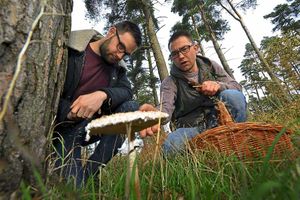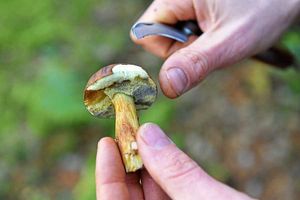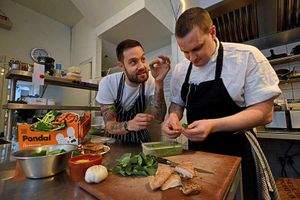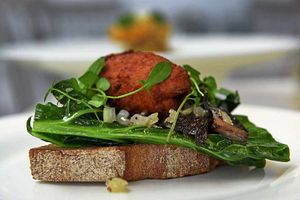Pick your own
Delicious Pied de Mouton and chanterelle mushrooms, wild chervil, juicy bilberries and fresh elderflowers.

Sounds like produce you'd pay a fortune for if you bought it by the pound down at your local greengrocer.
But these are just a few of the fine foods that you can pick up for free, perhaps just a stone's throw from where you're sitting right now.
Supermarkets are often at war as to who can supply food at the best price, but the cheapest supplies can be found in your own garden, local park or even on a walk through a churchyard.
As Alex Claridge, development chef at Birmingham restaurant Bistro 1847, puts it: "If we fancy green beans, we'll happily go to the supermarket and buy some that have travelled 4,000 miles across the globe for a few quid.

"We'll go to the supermarket and spend two or three pounds on a punnet of blackberries. These are all things we can get for free, that are growing right here in England."
At Bistro 1847, Alex and head chef Brian Smith work with professional foragers to source what could be considered unusual ingredients, despite having been grown here for centuries.
They include mushrooms, salad leaves, herbs and vegetables that can produce some delicious meals.
We visited Cannock Chase with Alex and professional forager Mike Wilkes to see what produce we could find in our neighbouring countryside.
Mike, 32, has been foraging for a few years now, influenced by Les Hiddins – the Bush Tucker Man – woodsman Ray Mears and chef Hugh Fearnley-Whittingstall.
As we searched for delicacies, he told us: "I have always been a keen cook and foodie and wanted to explore edible possibilities beyond the bland and often unseasonal, imported rubbish in the shops.
"I am a keen angler so have always had a kind of primitive instinct to hunt and gather. Coupled with an interest in nature meant that foraging for me was a very natural progression.
"I am extremely thrifty and resourceful and I find it empowering to gather amazing free food. Often you can pick some real delicacies, funghi such as ceps, Pied de Mouton and chanterelles, which would otherwise cost up to £50 per kilo in places like London's Borough Market."
The forage yielded a number of delicious finds, including hairy bittercress, sheephead sorrel, wood sorrel, parasol mushrooms and wood blewit mushrooms, all of which were taken back to the bistro to be cooked.

As Alex created a number of delicious dishes from the finds, we spoke to Mike about safe and easy ways to forage food at home.
"Safety is important when foraging – particularly when it comes to funghi as there are many species that are poisonous.
"Anything that you cannot safely identify with the five senses should be avoided. Yellow stainer mushrooms are the most common cause of fungal poisoning in the UK and to the untrained eye look like horse mushrooms and field mushrooms, though they are actually very easy to tell apart once you know how.
"Hemlock is a deadly poisonous member of the carrot family and can be mistaken for cow parsley. Another plant called lords and ladies can also be unwittingly picked whilst harvesting wild garlic – I've done it myself!"
Churchyards
Transitional seasons are a good time to harvest foods locally. Mike explains: "Spring is a great time to find things like wild garlic and nettles, and autumn for fruits such as bilberries and damsons, which are my favourite!
"Woodlands, especially beech, oak, birch and Scots pine are best for finding fungi. I also forage on golf courses and churchyards for mushrooms.
"Parks and canal towpaths are good places to forage for hedgerow fruits and elderflowers and things like meadowsweet. Search allotments for naturally growing greens such as chickweed and fat hen, as they love disturbed ground."
Alex cooked up a culinary storm with the discovery, creating potato crackling parasols with a hairy bittercress emulsion, grilled sourdough and wood blewits with garlic and sorrel and a broad bean ice cream with broad bean tops.

Head chef Brian explains his passion for indigenous foods: "Today as chefs we are exposed to a tantalising array of new gadgetry and technique. The seemingly endless displays of creativity. It's cool, it screams to the inner child, colours, textures, and disguised flavours strewn across the plate.
"I feel like I've missed something, like falling asleep in the middle of a conversation. It's all about the flavour, grand you are, but what about the raw ingredient?
"It has taken a while, but I understand my problem with being a chef. We are not using what is around us. Ten minutes in the semi-wild allotment we use at the restaurant, I have fennel fronds, seeds and pollen, nasturtium flowers, leaves and stems, borage, marigold, wild mint, onion seeds and blackcurrant sage.
"It's a privilege as a cook to have this. It's a joy to see the reverence my young staff have in this process, in finding out what is on our doorstep.
"At the restaurant we are supplied by several foragers. From a small company through to individuals. Every day there are new plants on offer, what I can get from them helps drive the menu. It's exciting times when the box arrives, like a kid at Christmas.
"It's fun to look back through old cook books and recipes, to see these plants being used. I feel more honest as a chef cooking with the fantastic flora of this island. Knowing that our forefathers and mothers have eaten these plants for hundreds of years.
"It deepens my connection to this wonderful green and pleasant land."
When you're out walking the dog or getting a breath of fresh air this weekend, have a closer look at the weeds and plants that you come across. It may be that they are the door to a new culinary experience that will quickly turn your everyday cooking into something special.
Mike adds: "Practice and experience are the best ways to ensure what you're foraging and eating is safe. You need some good books to cross reference your finds with. There are also websites where you can upload photos of your finds for experts to identify.
"It is unsafe to rely on Google images for ID as some images are tagged wrongly by people who are not sure themselves, and it's crucial that you know what you're eating is safe."
Bistro 1847 is holding a Foraged and Wild food supper with Mike on November 18. For more details or to book a place, visit bistro1847.com
By Kirsty Bosley





